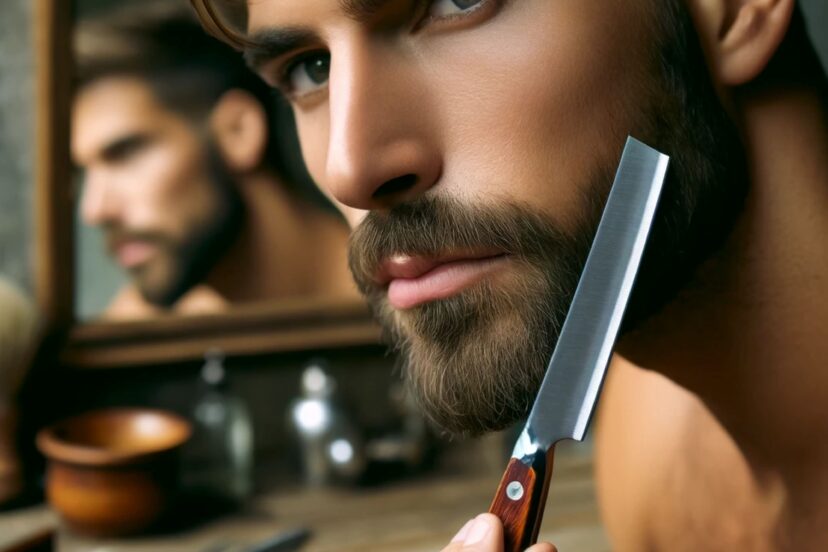Shaving with a Knife: Expert Tips for a Close, Clean Shave
Post Disclaimer
*We may earn a commission for purchases made using our links. Please see our disclosure to learn more.
Many people find shaving to be a tricky task. They might end up with cuts, bumps, or just not getting that smooth feel they want. Shaving with a knife, also known as a straight razor, is an age-old technique that promises a close and clean shave when done right.
Shaving with a straight razor can give you more control and potentially lead to better results than modern razors. In this article, we’ll share expert tips on choosing the right knife for shaving, preparing your skin correctly, mastering the technique for that perfect shave, and maintaining your blade so it lasts longer.
Read on for smoother skin!
Shaving with a Knife: The Traditional Art
Shaving with a knife, or more traditionally known as straight razor shaving, is an art that has refined the grooming routine of many. It involves a precise technique and a steady hand to ensure a close shave without irritation.
This method not only provides a smooth shave but also turns the daily task into a meditative ritual, reflecting patience and skill. The satisfaction of mastering straight razor shaving lies in achieving that perfect clean shave with just a single blade against your skin.
In every stroke, there’s an art; in every shave, a story.
Selecting the ideal knife for this traditional practice requires understanding the differences between straight razors and safety razors, alongside considerations such as material and blade sharpness.
Moving on to choosing the right knife will lay down the foundation for enhancing this timeless shaving experience.
Choosing the Right Knife for Shaving
When selecting a knife for shaving, consider the benefits of a straight razor versus a safety razor. Ensure that the blade is made of suitable materials and has the sharpness required for an effective shave.
Straight razor vs. safety razor
When choosing between a straight razor and a safety razor for shaving, it’s important to consider your experience level and the amount of time you want to dedicate to shaving. A straight razor provides an exceptionally close shave but requires precision and skill due to its single sharp blade.
On the other hand, a safety razor features a protective guard, making it ideal for beginners or those with limited time. Both razors provide excellent results when used with proper technique and quality products such as shaving cream or soap.
If you prefer classic grooming tools that require attention to detail and offer a nostalgic experience, a straight razor might be the perfect fit. However, if convenience and ease of use are more important to you without compromising on performance, then a safety razor is likely the better choice.
Materials
To ensure a smooth and precise shave, selecting the right materials is essential. Look for high-quality stainless steel razors for durability and precision. Additionally, consider investing in a good shaving brush made from synthetic or natural fibers for creating a rich lather when using shaving soap or cream.
Quality shaving soaps and creams containing moisturizing ingredients can provide lubrication and hydration to your skin during the shave.
For individuals seeking self-improvement in their shaving routine, choosing suitable materials plays an integral role in achieving a comfortable and effective experience.
Blade sharpness
To achieve a smooth and close shave without irritation, it’s essential to pay attention to blade sharpness. A sharp blade is crucial for effortlessly cutting through the hair and reducing the risk of nicks or razor burn.
Dull blades can cause tugging, resulting in discomfort and uneven shaving results. When selecting a shaving knife, ensure that the blade is honed to perfection for an effective and comfortable shaving experience.
Maintaining your knife’s blade sharpness is key to achieving a close shave without irritation. Regular stropping and honing will help keep the blade in top condition, ensuring optimal sharpness for each use.
Expert Tips for a Close, Clean Shave
To achieve a close, clean shave, ensure thorough preparation and use proper technique. Incorporate a shaving brush and soap for lathering, then finish with an alum stone to soothe the skin.
For more on expert tips for a smooth shave, read the full article.
Proper preparation and technique
Before shaving, properly prepare your skin by taking a warm shower or using a hot towel to soften the hair and open up your pores. Apply pre-shave oil to create a protective barrier and allow the blade to glide smoothly over your skin.
Use a high-quality shaving brush to lather shaving soap onto your face in circular motions, lifting and softening the whiskers for an easier shave. When shaving with a knife, hold it at a 30-degree angle for safety razors or maintain a 15-20 degree angle for straight razors.
Begin with light, short strokes in the direction of hair growth before re-lathering and going against the grain for that ultra-smooth finish.
Using proper technique is crucial when shaving with a knife. Always start by holding the razor lightly – let its weight do most of the work instead of applying excess pressure on your skin which can lead to irritation and nicks.
Using a shaving brush and soap
Achieving a superior lather is essential for an exceptional shaving experience. Gently soak the shaving brush in warm water, then shake off excess moisture. Begin swirling the brush in a circular motion across the soap until it forms a rich, creamy lather.
Apply the lather to your skin using brisk, circular motions to lift and soften the hair.
For Men, Women, Professionals, Individuals seeking self-improvement, Teens and young who want clean shave techniques or close shave methods without irritation while diving into wet shaving with traditional razor techniques or getting smooth shaves with blade soaps and brushes.
Finishing with an alum stone
After using a shaving brush and soap, finish off your shave by rubbing an alum stone over your skin. The alum stone has natural antiseptic and astringent properties that can help to soothe any minor nicks or irritation caused during shaving.
It also acts as an effective aftershave by tightening the pores and leaving the skin feeling smooth and refreshed.
For a close, clean shave without irritation, consider incorporating the use of an alum stone into your post-shave routine. Its natural properties make it especially beneficial in reducing redness and soothing sensitive skin after shaving with a knife or razor blade.
Maintaining Your Shaving Knife
Maintain your shaving knife by regularly stropping and honing the blade for optimal sharpness. Store your knife properly to prevent damage and maintain its quality over time.
Stropping and honing
To keep your shaving knife in top condition, it’s crucial to regularly strop and hone the blade. Stropping involves running the blade along a leather strop to realign its edge and remove any burrs or imperfections.
Regular stropping helps maintain the sharpness of the razor for a smooth, clean shave. Honing is similar to sharpening but focuses on refining and perfecting the blade’s edge using finer grit materials such as honing stones or pastes.
By honing your razor, you ensure that it stays exceptionally sharp, contributing to an irritation-free and close shave every time.
Proper storage
To keep your shaving knife in top condition, store it in a cool, dry place to prevent rust and deterioration. Make sure the blade is completely dry before putting it away. A dedicated razor case or storage box can protect the blade from damage and keep it safe from curious hands.
Proper storage not only prolongs the lifespan of your shaving knife but also ensures its safety when not in use.
Next topic: “Conclusion”
Conclusion
Achieving a close, clean shave with a knife requires proper preparation and technique. Using a shaving brush and soap help to soften the hair and exfoliate the skin, while finishing with an alum stone reduces irritation.
Stropping and honing your shaving knife regularly is crucial for maintaining its sharpness. Proper storage will also ensure that your knife lasts longer. These expert tips will help you master the art of shaving with a knife for a smooth, flawless look every time.
FAQs
1. How can I get a close shave with a knife without causing irritation?
To achieve a close shave with a knife or straight blade while avoiding irritation, use sharp shaving tools, apply plenty of shaving cream for lubrication, and shave in the direction your hair grows.
2. What are some expert tips for shaving with a traditional razor?
Experts recommend preparing your skin with warm water to soften the hair, using a sharp traditional razor or safety razor, and following up with gentle skin care products to keep your skin smooth and free from cuts.
3. Can you achieve a clean shave using just a straight blade?
Yes! Shaving with a straight blade can give you an exceptionally clean shave. Practice proper techniques like holding the blade at the right angle and taking slow, careful strokes for the best results.
4. Are there any tricks to prevent cuts when shaving with a knife?
When shaving with any sharp tool like a knife or straight razor, ensure it’s properly sharpened, take your time during each stroke to maintain control, and use short strokes over tricky areas to minimize cuts.
5. What should I do after shaving for healthy skin?
After shaving with any type of blade—be it traditional razors or knives—it’s crucial to rinse your face with cool water, apply an alcohol-free aftershave product to soothe the skin, and moisturize well to keep it hydrated.




